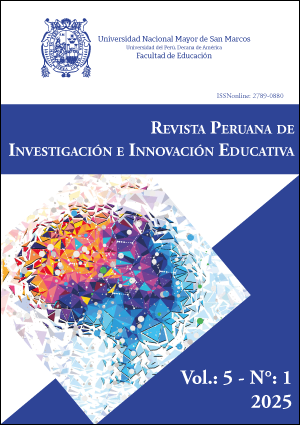Impact of using MATLAB on meaningful learning of Ordinary Differential Equations in Environmental Engineering students
DOI:
https://doi.org/10.15381/rpiiedu.v5i1.30362Keywords:
MATLAB, meaningful learning, ordinary differential equationAbstract
The purpose of the study was to evaluate the impact of the use of MATLAB software on the meaningful learning of Ordinary Differential Equations in Environmental Engineering students at the National Agrarian University La Molina during the year 2022. A quasi-experimental design was used with the participation of 40 students selected in a non-probabilistic manner, distributed in two groups: one experimental (20) and one control (20). The instruments used were a questionnaire and a scale that was applied to both groups at two times (pretest and posttest). The data obtained were analyzed using descriptive and comparative statistical techniques. The results of the posttest showed that the experimental group achieved a higher average compared to the control group. The analysis of the hypotheses, carried out using the t-Student test, showed a p-value of 0.00, which is lower than the significance level of 0.05, indicating a significant difference. In conclusion, the use of MATLAB software had a positive and significant impact on the learning of ordinary differential equations in Environmental Engineering students.
References
Ashburn, A., & Floden, E. (2006). Meaningful Leaming Using Technology: What Educators Need to Know and Do. Teachers College Press.
Ausubel, D. Novak, J., & Hanesian, H. (1983). Psicología educativa. Un punto de vista cognoscitivo. Editorial Trillas.
Díaz, F., & Hernández, G. (2010). Estrategias docentes para un aprendizaje significativo. Una interpretación constructivista. McGraw-Hill Interamericana editores.
Dullius, M. (2009). Enseñanza y aprendizaje en ecuaciones diferenciales con abordaje gráfico, numérico y analítico. [Tesis Doctoral, Universidad de Burgos]. https://redined.mecd.gob.es/xmlui/handle/11162/161765
George, D., & Mallery, P. (2003). SPSS Statistics for Windows step by step: A Simple Guide and Reference. 11.0 Update. Allyn & Bacon.
Guerrero, C., Camacho, M., & Mejía, H. (2010). Dificultades de los estudiantes en la interpretación de las soluciones de las ecuaciones diferenciales ordinarias que modelan un problema. Enseñanza de las ciencias, 28 (3), 341-452.
Gutiérrez, R. (2019). Aplicación del software MATLAB en el aprendizaje del cálculo integral de los estudiantes de ingeniería con experiencia laboral de la universidad peruana de ciencias e informática, 2018. [Tesis de Maestría, Universidad Peruana de Ciencias e Informática]. https://repositorio.upci.edu.pe/handle/upci/50
Hernández, R., & Mendoza, C. (2018). Metodología de la investigación. McGraw-Hill Interamericana editores, S.A. https://repositorio.uandina.edu.pe/handle/20.500.12557/3346
MathWorks. (2022). MATLAB. Recuperado de https://www.mathworks.com/products/matlab.html
Mogrovejo, S. (2017). Uso de MatLab y su influencia en el rendimiento académico del curso de métodos numéricos en los estudiantes de la escuela profesional de ingeniería civil de la universidad andina del cusco, 2017. [Tesis de Doctorado, Universidad Andina del Cusco].
Moreira, M. A. (1999b). Aprendizagem Significativa. Fórum Permanente de profesores. Ed. Universidade de Brasília.
Pantoja, H. (2015). Aplicación del software libre Sage, en el rendimiento ·académico del curso de Cálculo Vectorial, en los estudiantes del IV Ciclo de Ingeniería Mecánica de la Universidad Nacional de Ingeniería. [Tesis Doctoral, Universidad Nacional de Educación Enrique Guzmán y Valle]. Repositorio Institucional - Universidad Nacional de Educación Enrique Guzmán y Valle.
Pérez C. (2002). MATLAB y sus Aplicaciones en las Ciencias y la Ingeniería. Universidad Complutense de Madrid. Pearson Educación.
Pernalete, N. (2010). MatLab como estrategia para la enseñanza-aprendizaje de la matemática en educación superior. Universidad Nacional Experimental Rafael María Baralt. http://www.iiis.org/CDs2008/CD2009CSC/SIECI2009/PapersPdf/X358HZ.pdf
Downloads
Published
Issue
Section
License
Copyright (c) 2025 Ely Oliver Guardia Jara, Florencio Flores Ccanto, Carmen Oly Elisa Soria Mendo

This work is licensed under a Creative Commons Attribution 4.0 International License.
AUTHORS RETAIN THEIR RIGHTS:
The authors retain their trademark and patent rights, and also on any process or procedure described in the article.
The authors retain the right to share, copy, distribute, execute and publicly communicate the article published in Revista peruana de investigación e innovación educativa (for example, place it in an institutional repository or publish it in a book), with an acknowledgment of its first publication in Revista peruana de investigación e innovación educativa.
The authors retain the right to make a subsequent publication of their work, to use the article or any part of it (for example: a compilation of their works, notes for conferences, thesis, or for a book), provided that they indicate its first publication in Revista peruana de investigación e innovación educativa (referencing authors of the work, journal, volume, number and date).






